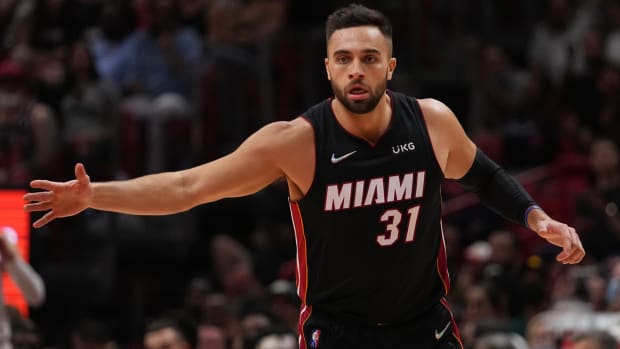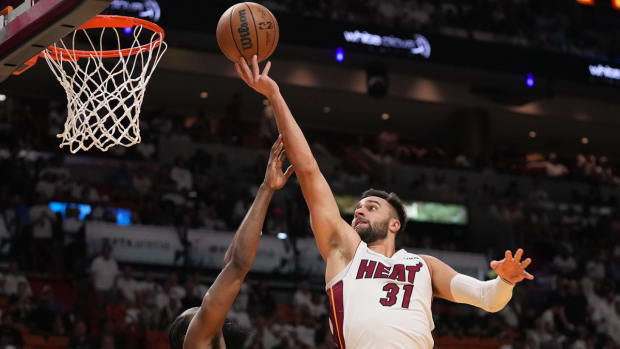In late March, the Heat were teetering.
First, they lost a dispiriting game against a Sixers team resting Joel Embiid and James Harden. Miami followed that up with a double-digit loss to a Warriors team missing Stephen Curry, Klay Thompson and Draymond Green—which included a sideline blowup between Jimmy Butler and Erik Spoelstra. Then came a blown 17-point fourth-quarter lead to the Knicks. And, finally, a blowout loss at the hands of the Nets. By the end of the four-game slide, the Heat had slipped to 47–28, their grip on the No. 1 seed in the East loosening with each loss.
Spoelstra knew he needed to spark the team. With the postseason approaching in less than a month, the first-place Heat required a rotational overhaul. So after a fourth straight disappointing defeat, in a team meeting, Spo announced a late-season change to the starting lineup. Sharpshooting specialist Duncan Robinson was out.
Undrafted Max Strus was in.
Strus, who scored 11 points while adding two assists and four rebounds in Game 1 of the Eastern Conference finals, is the latest in a Disney World–worthy long line of Heat reclamation projects who’ve struck daggers into the hearts of opponents. The 26-year-old is in his third season out of DePaul, where he spent two seasons following two years at Lewis University. And he’s been a key factor in the Heat’s success since their March wobble. After Spo made him a starter, the Heat have won 15 of the 18 games Strus has appeared in and are now only three wins away from the NBA Finals.
“We were going through a tough time as a team,” Strus says. “I really didn’t know what to expect, to be honest. I knew it would be for a couple games, at least. I didn’t know how long it would last. You work your whole career to be a big-time player at this level.
“Whether you start or not, playing meaningful minutes is huge. I was just super grateful and happy to be inserted into the starting lineup. And it’s been working.”
Working is an understatement. In the postseason, Miami has been thriving with Strus opening the game. The Gabe Vincent–Jimmy Butler–P.J. Tucker–Bam Adebayo–Strus lineup that started eight games during the playoffs boasts a 27.3 net rating. With Kyle Lowry in place for Vincent, the net rating stays steady at 27.1. Strus enters Game 2 against the Celtics with the second-best plus/minus on the team behind only Butler in the playoffs. In Strus’s nearly 30 minutes a night on the floor, Miami is posting elite efficiency numbers on both ends of the floor.

Jasen Vinlove/USA TODAY Sports
While Strus has emerged from relative obscurity to be a key cog in the success of the No. 1 team in the East, one person who is not surprised is Scott Trost, Strus’s head coach during his two seasons at Lewis. Trost coached Strus’s older brother Marty years before recruiting Max, who despite a successful high school career, had very little interest from Division I schools headed into college.
“I think Max’s greatest trait is he believed in himself probably when other people didn’t,” Trost says. “He wanted to prove people wrong. And he’s certainly done that.”
Strus was a certified bucket-getter during his days at Lewis, a small school located roughly 30 miles southwest of Chicago. He once scored 52 points as a sophomore, shooting 12-of-14 from three. And he was highly motivated by slights. Trost remembers one school that invited Strus to its elite camp for incoming freshmen but placed him on one of the courts in the back gym with the less sought-after recruits. When Strus played that school with Lewis as a freshman, he had one of his best scoring nights of the season.
“There’s nobody that worked harder at his game than Max,” Trost says. “When you tell Max he can’t do something, or that he’s not good enough, he uses that as motivation.”
Strus participated in Summer League with Boston in 2019 but was cut before the season. He appeared in only two games his rookie year with the Bulls before tearing his ACL and missing most of the year. In November 2020, he signed a training-camp contract with the Heat, who converted him into a two-way player in December of that year. He played in 39 games—no starts—his first year with Miami. And Strus recognized he needed to make serious improvements to become a consistent rotation member.
Between Summer League and his personal work, Strus says his offseason was short-lived. He wasn’t happy with his shooting percentage from last season (33.8% from three) so he started with getting as many shots up as possible. He also studied tape of shooters like Joe Harris and Klay Thompson, hoping to emulate what they could do on the move as well as the defensive end of the floor. And he worked on his body to get in better shape so he could hold up when matched up against perimeter stars.
The shooting improvement was stark. Strus connected on 41% of his threes during the regular season on 6.5 attempts a night. The only players who shot a better percentage than Strus who took at least as many threes a night were Kyrie Irving, Lonzo Ball and Desmond Bane. Strus is an elite spot-up shooter, who can also wiggle free coming off screens. Against the Celtics in Game 1, two of his three-point makes came from zooming around the wing, receiving a handoff and firing quickly when given an inch of daylight.
Watch NBA games online all season long with fuboTV: Start with a 7-day free trial!
Strus’s shooting prowess is imperative to keeping the Heat’s offense flowing. Miami can struggle in the half court, and Butler and Adebayo need all the space they can get to operate properly. But none of this works if Strus can’t stand his ground defensively.
It’s no secret that Strus is the obvious target for opponents in the Heat’s starting lineup, particularly when Miami’s preference is to switch on nearly every screen. And it’s a challenge Strus knew he had to be ready to meet headed into the season.
“Defense is more of a want-to thing more than anything,” he says. “There’s also a lot you can learn. P.J. Tucker has been one of the biggest helps for me this season, trying to put me in the right situations and always in the right spots.”

Jasen Vinlove/USA TODAY Sports
Strus adds when teams try to pick on him with their best scorers, he takes it personally.
“It’s do whatever you can to get the stop,” he says. “I’m going to force him into things they don’t like to do.”
And so far during the postseason, Strus has held true to his word. Per Synergy Sports, Strus is allowing a paltry 0.643 points per possession on the 28 isolations he’s defended through the playoffs, with opponents shooting only 7-of-20 in those situations. Per NBA.com’s matchup data, James Harden and Trae Young combined to shoot only 5-of-20 when guarded by Strus. The Celtics are going to provide an even greater challenge with Jayson Tatum and Jaylen Brown on the perimeter, but even if Strus isn’t a lockdown guy, making it difficult for Boston’s stars goes a long way for Miami.
In Game 1, Strus’s only two-point basket came on a perfectly timed dig. With Tatum driving the lane, Strus crashed into the paint and stole the ball as Tatum tried to get by Adebayo, running the other way for an easy score at the rim. Those were the kind of reads Strus wasn’t making early in the season, and it’s a point of pride for him to be making those plays to aid the work done by the stars on his team. A significant part of Strus’s improvement this season was earning the trust of the likes of Butler and Tucker.
“Everything I’ve worked for was to help them out,” Strus says. “As a young guy in the NBA, you just want to make it as easy as possible on them and provide help and comfort. Honestly, guys like that, all they want you to do is play hard and compete as hard as possible. We’re all kind of built the same way, and I fit right in.”
One issue that arises with late adjustments to the rotation is the lineup uncertainty it can create headed into the playoffs. With injury issues throughout the regular season, the Heat never established a bona fide closing lineup that was going to be the obvious choice to employ in high-leverage moments. While the Heat may still not have a definitive finishing group, Strus has appeared in their five most-used fourth-quarter lineups. And thanks in large part to his defensive improvement, he was on the floor to close against Boston, hitting a couple of threes in the final frame while Sixth Man of the Year—and Miami’s second-leading scorer during the regular season—Tyler Herro was on the bench.
The same guy whose D-II coach was trying to coax him into playing better defense is now staying on the floor in high-stakes NBA games, specifically because he can survive on that end of the court. Though the road to this exact moment was winding—two colleges, cut by the Celtics, a torn ACL, cut by the Bulls, a two-way contract with the Heat—Strus always imagined himself in this position.
“Throughout the adversity and all the downs I had early on in my career, I never wavered in my confidence,” Strus says. “The only question was whether or not I would get another chance. The NBA is short-lived; some guys only get one crack at it. Once I had my ACL, I didn’t know if a team was gonna give me a chance again. So I’m very thankful for the Heat for giving me the opportunity.”
Considering where the Heat were before making Strus a starter, and how far they’ve come since, the feeling must be mutual.
- Heat Use Speed to Slow Down Celtics in Game 1
- NBA Mock Draft: Magic Win Lottery, Latest Projections
- Behind the Scenes of the NBA Draft Lottery
- Key Questions for Mavericks-Warriors Western Conference Finals
Sports Illustrated may receive compensation for some links to products and services on this website.







